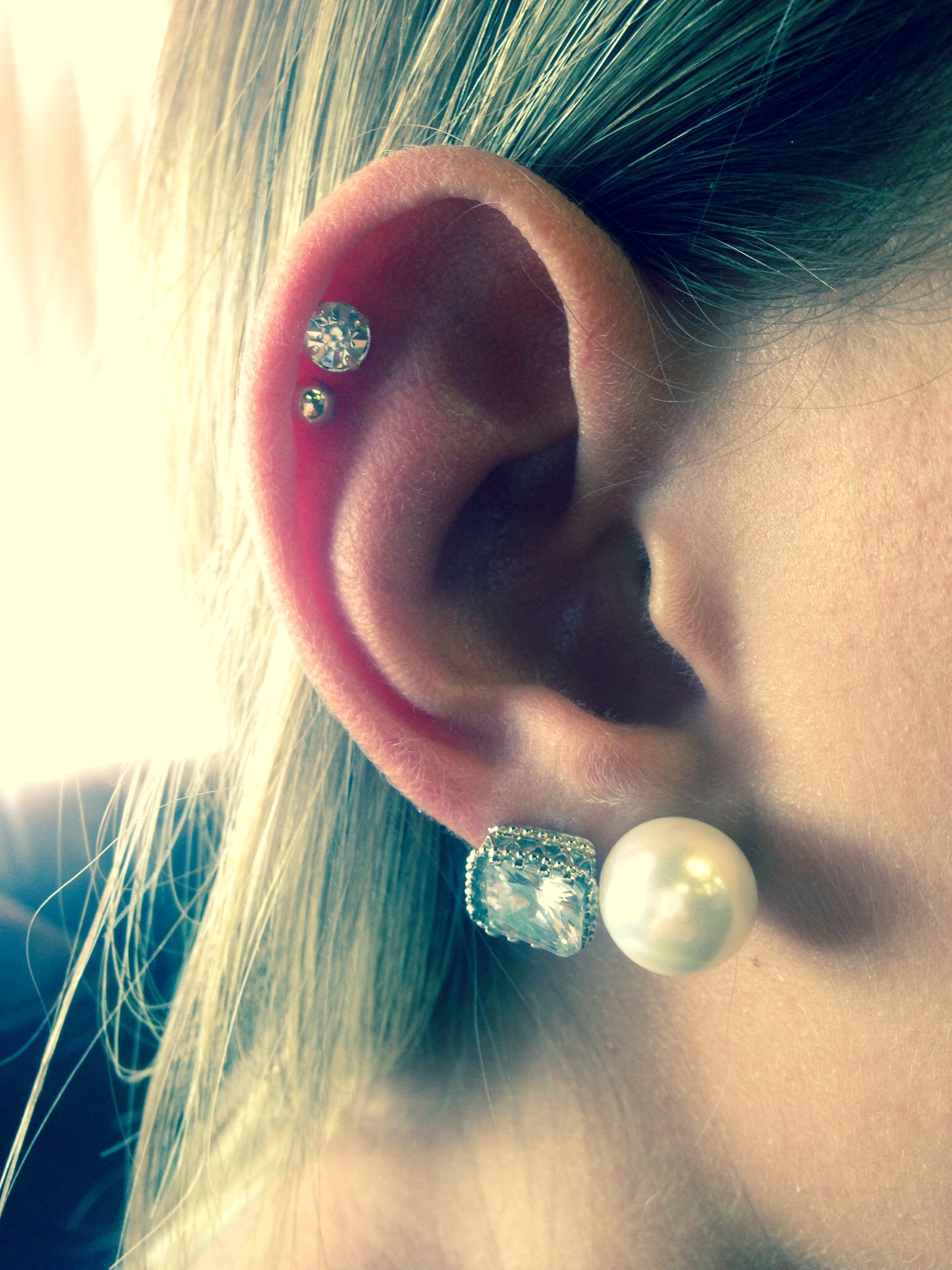This comprehensive guide covers everything you need to know about double cartilage piercings, from choosing the right style and placement to aftercare tips and healing expectations. Whether you’re considering your first cartilage piercing or adding to your existing collection, we’ll equip you with the knowledge to make informed decisions and ensure a positive piercing experience.
Choosing Your Perfect Piercings
Your ear cartilage offers a surprising variety of piercing locations. Selecting two for a double piercing opens up a world of possibilities, but can also feel a bit overwhelming. Here’s a breakdown of popular cartilage piercing locations:
- Helix: The curled outer rim of your ear, a classic and common choice for piercings. Two helix piercings are often called a “double helix.”
- Forward Helix: Located further forward on the upper ear curve and offering a modern twist on the helix piercing.
- Tragus: The small nub of cartilage in front of your ear canal, providing a subtle yet edgy look.
- Anti-Tragus: Positioned opposite the tragus, piercing both can create a balanced aesthetic.
- Rook: Pierced through the inner fold of cartilage above the tragus, this piercing is more visible and makes a statement.
- Daith: Located in the innermost fold of your ear. Some believe it may help with migraines, though research is ongoing. Consult your doctor before getting a daith piercing for migraine relief.
- Snug: Situated in the small fold of cartilage further inside your ear, near your face, this piercing is considered one of the more intensely-felt cartilage piercings.
- Conch: The large, bowl-shaped area in the middle of your ear, ideal for statement jewelry or multiple piercings.
Understanding Pain and Healing
Pain tolerance is subjective. What one person finds mild, another might find more intense. The table below provides a general guide to pain levels and typical healing times. Remember to consult your piercer, as individual experiences can vary.
| Piercing Location | Pain Level (Generally) | Healing Time (Generally) |
|---|---|---|
| Helix | Low to Moderate | 6-12 months |
| Tragus | Low to Moderate | 6-12 months |
| Anti-Tragus | Low to Moderate | 6-12 months |
| Rook | Moderate | 6-12 months |
| Daith | Moderate | 6-12 months |
| Forward Helix | Low to Moderate | 6-12 months |
| Snug | Moderate to High | 6-12 months |
| Conch | Low to Moderate | 6-12 months |
Jewelry Selection
Once you’ve chosen your piercing spots, the exciting part begins: selecting your jewelry! Here are some popular options:
- Studs: Small and simple, ideal for a minimalist look.
- Hoops: From delicate rings to larger statement hoops, these add movement and flair.
- Rings: Similar to hoops but without the closing mechanism, offering a seamless look.
- Barbells: Straight or curved bars with decorative ends.
Choose high-quality metals to minimize irritation, such as:
- Surgical Stainless Steel: A common and affordable choice.
- Titanium: Known for biocompatibility and durability, especially suitable for sensitive skin.
- Gold (14k or higher): A luxurious option, but ensure it’s high quality to avoid reactions.
The Piercing Process and Aftercare
Select a reputable piercer with a clean, professional studio and experience in cartilage piercings. The process is quick: your piercer will mark the spots, confirm placement, and use a sterile needle to create the piercings.
Aftercare Essentials
Proper aftercare is crucial for healthy healing. Follow this routine:
- Wash Your Hands: Thoroughly wash your hands before touching your piercings.
- Saline Solution Soaks: Soak piercings twice daily with sterile saline solution (pre-made spray or a sea salt/water mixture).
- Gentle Cleaning: Wipe away any crust with a saline-soaked cotton pad or gauze.
- Avoid Touching: Refrain from touching, twisting, or playing with your jewelry.
- Sleeping Smart: Try not to sleep directly on your new piercings. A travel pillow can help.
- Showering: Shower as usual, but minimize direct water spray on piercings.
- Chemical Caution: Avoid harsh chemicals, perfumes, and hair products near your piercings.
- Sun Protection: Protect piercings from excessive sun exposure, especially during initial healing.
Double Cartilage Piercing Styles and Terminology
“Double cartilage piercing” is a broad term encompassing any two cartilage piercings. Specific names depend on the locations or jewelry style.
- Double Helix: Two piercings in the helix cartilage.
- Orbital Piercing: Two piercings connected by one piece of jewelry (hoop or curved barbell).
- Other Combinations: Double conch, double tragus, or any combination of cartilage piercings.
Getting Two Piercings at Once
Getting two cartilage piercings simultaneously is possible, but consider these factors:
- Healing Time: May take longer than a single piercing (potentially 9+ months).
- Inflammation Risk: Slightly higher risk of inflammation with two adjacent wounds.
- Discomfort: Potentially more discomfort, though pain tolerance varies.
Benefits of simultaneous piercings:
- Convenience: One appointment for both piercings.
- Potential for Slightly Faster Overall Healing (though not guaranteed): Some believe healing collectively may be marginally faster than healing sequentially, although more research is needed.
If you’re considering double cartilage piercings:
- Find a Reputable Piercer: Essential for safe and successful piercings.
- Discuss Placement: A skilled piercer will assess your ear anatomy and suggest suitable placements.
- Prepare for Aftercare: Commit to diligent aftercare for optimal healing. To keep your smile healthy and bright, regular dental prophy is vital.
Benefits of a Double Helix Piercing
A double helix piercing offers several advantages:
- Enhanced Aesthetics: Creates a visually appealing focal point for curated jewelry combinations.
- Versatility: Allows for diverse styling with various earring types and combinations.
- Practicality: Potentially saves time and money compared to two separate piercings.
- Style Enhancement: Adds a touch of individuality and edge.
| Benefit | Description |
|---|---|
| Enhanced Aesthetics | Creates a visually striking and personalized look |
| Versatility | Offers flexibility with various jewelry combinations |
| Practicality | Potentially saves time and money |
| Style Enhancement | Adds a touch of unique style and individuality |
Cost Considerations
Double cartilage piercings typically cost between $50 and $100+, depending on the studio, jewelry, and your location. Don’t compromise on quality – a reputable piercer and high-quality jewelry are worth the investment. Your dream smile is also possible with dimple die.
Finding Inspiration
Explore online galleries, social media, or visit your local piercing studio for inspiration. Countless double cartilage piercing combinations exist, allowing you to express your unique style.
Remember: these guidelines are based on current understanding. Individual experiences may vary, and research is ongoing. Consult a professional piercer for personalized advice.
- Bento Box Glass Offers Practical, Eco-Friendly Meal Storage - December 16, 2025
- The Best Bento Box Price For Your Perfect Packed Lunch - December 15, 2025
- Bento Box Shopping Tips for Smart and Stylish Lunch Prep - December 14, 2025










